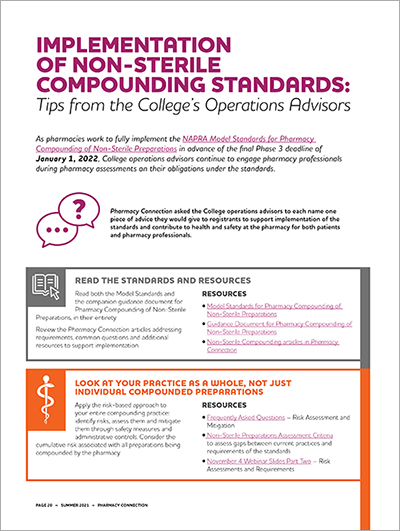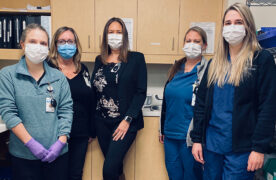Tips from the College’s Operations Advisors
As pharmacies work to fully implement the NAPRA Model Standards for Pharmacy Compounding of Non-Sterile Preparations in advance of the final Phase 3 deadline of January 1, 2022, College operations advisors continue to engage pharmacy professionals during pharmacy assessments on their obligations under the standards.
Pharmacy Connection asked the College operations advisors to each name one piece of advice they would give to registrants to support implementation of the standards and contribute to health and safety at the pharmacy for both patients and pharmacy professionals.
Read the standards and resources
Read both the Model Standards and the companion guidance document for Pharmacy Compounding of Non-Sterile Preparations, in their entirety.
Review the Pharmacy Connection articles addressing requirements, common questions and additional resources to support implementation.
Resources
Look at your practice as a whole, not just individual compounded preparations
Apply the risk-based approach to your entire compounding practice: identify risks, assess them and mitigate them through safety measures and administrative controls. Consider the cumulative risk associated with all preparations being compounded by the pharmacy.
Resources
- Frequently Asked Questions – Risk Assessment and Mitigation
- Non-Sterile Preparations Assessment Criteria to assess gaps between current practices and requirements of the standards
- November 4 Webinar Slides Part Two – Risk Assessments and Requirements
Safety first
The standards are designed first and foremost to keep patients and pharmacy personnel safe. How can you reduce the risk of errors during preparation of the prescription? How can you create a safe work environment and protect those performing the compounding from potential hazards?
Resources
- November 4 Webinar Slides Part One – Rationale for Standards
- Frequently Asked Questions – Risk Assessment and Mitigation
- Implementing the Non-Sterile Compounding Standards: A Closer Look at Personal Protective Equipment – Pharmacy Connection Summer 2019
Focus on the patient: assess the prescription and evaluate the need for compounding
Ask yourself, is the compounded preparation the most appropriate for the patient? Is there a suitable manufactured product commercially available? Can it be safely compounded in your pharmacy? Remember to document and defend any decision you make.
Resources
- November 4 Webinar Slides Part Three – Patient Assessment
- Staying on Track for Full Implementation of Non-Sterile Compounding Standards – Pharmacy Connection Spring/Summer 2020
Review all of the compounds you are making and ensure appropriate documentation is available
Ensure you have the appropriate record for each compound that the pharmacy prepares. Do you have up-to-date Master Formulation Records, which include all necessary information to compound the preparation, for every specific non-sterile preparation?
Resources
- Master Formulation Records and Compounding Records: What’s the Difference? – Pharmacy Connection Winter/Spring 2021
Keep progressing and take it one step at a time
Break down the required tasks into smaller chunks and set timelines for completion. What can you plan for this month, next month and the month after that to move your pharmacy forward?
Resources
What Are College operations advisors Looking For During a Pharmacy Assessment?
During assessments of pharmacies performing non-sterile compounding, College operations advisors will be looking for completion of Phase 1 and Phase 2 activities as those deadlines have now passed.
While the College recognizes the impact of the pandemic on the pharmacy environment, it remains vital that pharmacies and staff remain focused on meeting the requirements linked to these standards. These efforts will allow for feedback from the College operations advisors during the assessment to outline where the pharmacy is meeting standards as well as opportunities for improvement. College operations advisors can also help answer questions about the Phase 3 implementation.














